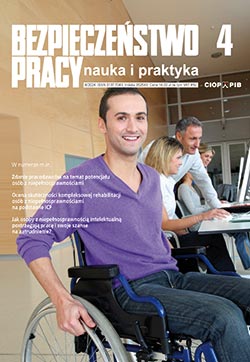How to prevent accidents in agriculture?
Anna Groborz
This article presents basic directions of farmersʼ activities aimed at improving their occupational safety and at minimizing exposure to hazards of other inhabitants and workers in the same farm. Agriculture is one of the worst sectors of the Polish economy regarding hazards. Despite the downward trend in fatal accidents, preventive measures should be promoted, such as participating in training courses in occupational safety, developing a lifelong habit of proper work techniques when handling heavy objects, maintaining a safe workplace and using appropriate personal protective equipment.
Dust hazards in a chimney sweepʼ
Marek Chyc, Bogna Burzała, Renata Szczygłowska
Soot, dust, flammable and toxic chemical compounds are among the many threats present at a chimney sweepʼs workstation. Chimney sweeps are exposed to hazardous chemical compounds such as polycyclic aromatic hydrocarbons, dioxins (PCDD/F) and heavy metals. Those agents cause occupational diseases, among which carcinoma is the most dangerous one. Personal protection equipment can efficiently protect workers against the impact of poisons.
Tools supporting an analysis of the state of safety at schools (2)
Krystyna Myrcha, Mariusz Dąbrowski
This article discusses practical methods of identifying weak spots at schools with checklists. It also presents essential rules for reducing the risk of injury and proposes safety practices at schools. All of these tools can help school principals meet the legal requirements related to routine reviews of school safety and reducing the accident rate.
Promoting workplace health - good practices (2)
Marzena Malińska, Anna Namysł, Katarzyna Hildt-Ciupińska
In reference to an earlier publication (“BP” No. 6), which discussed workplace health promotion, this article also provides examples of good practice in Poland and abroad. It focuses on the effectiveness and need for health promotion programmes in the workplace. Literature and research show several important initiatives in this area relating to physical activity, disease prevention, diet, smoking, stress reduction, social packages and working conditions.
How does discomfort glare change at various locations of the obseverʼ
Agnieszka Wolska
Discomfort glare is a parameter of lighting which is not objectively evaluated – throughout measurements at workstations. This is done only when interior lighting is designed. Unified glare rating (UGR) is a measure of evaluating glare limitation; its values for typical points of the room are calculated via a computer program and compared with the requirements of PN-EN 12464-1. This article presents data on how the value of UGR changes at the various locations of the observer’s eye in relation to a single glare source using a typical office room as an example. Practical advice is offered.
Signalizing the effectiveness of gloves protecting against chemical compounds
Rafał Hrynyk
Full-rubber protective gloves have become primary protective equipment for employees exposed to contact with liquid chemical substances. Irrespectively of the material used to produce the gloves and their effectiveness in relation to contact with liquid chemical substances, time of their use is limited. This article presents data on the requirements for full-rubber gloves, especially regarding chemical perforation time stamps of gloves defined in laboratory tests as well as their levels of effectiveness. This article also discusses basic problems connected with using this kind of gloves; it presents methods of signalizing chemical perforation, using a test method with microcapsules containing dye indicators, which was developed in CIOP-PIB.




























